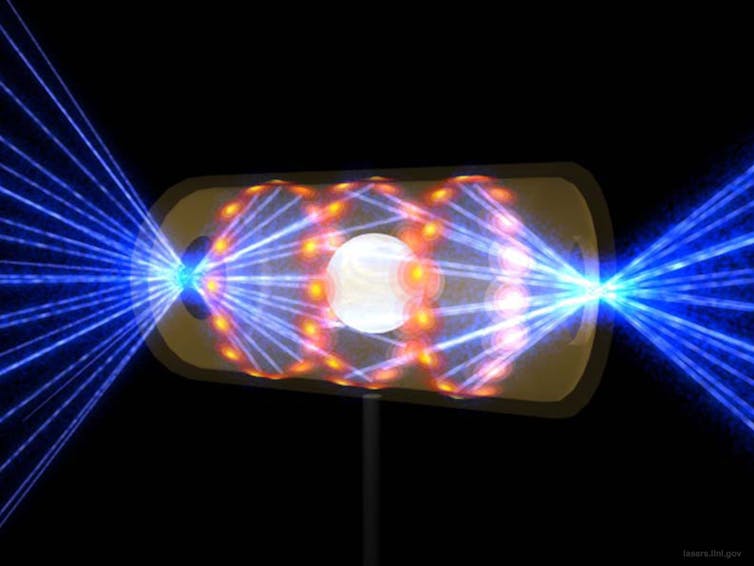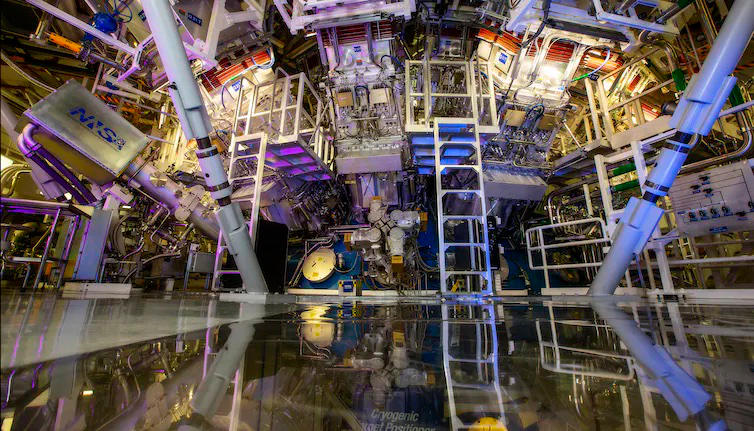Justin Wark, University of Oxford and Gianluca Gregori, University of Oxford
Nuclear fusion holds huge promise as a source of clean, abundant energy that could power the world.
Now, fusion researchers at a national laboratory in the US have achieved something physicists have been working towards for decades, a process known as “ignition”. This step involves getting more energy out from fusion reactions than is put in by a laser.
But just how close are we to producing energy from fusion that can power people’s homes? While ignition is only a proof of principle and a first step in a very long process, other developments are also in the works and together they could spark renewed enthusiasm for making fusion a practical reality.
First it’s important to recognise that the latest result is indeed a real milestone. The researchers at the National Ignition Facility (NIF) in California fired the world’s biggest laser at a capsule filled with hydrogen fuel, causing it to implode and starting fusion reactions that mimic what happens in the Sun.
The fusion energy released by the implosion was more than that put in by the laser, a massive achievement given that, just a few years ago, the NIF laser could only get out about a thousandth of the energy it put in.
However, around 10,000 times more energy had to be put into the laser than it produced in light energy. It can only be run once a day. And every target is so exquisitely designed that each one costs thousands of dollars.

To produce a reactor for a working power station, you would need a laser that produced light energy at much greater efficiency (a few tens of percent) and shot targets successfully at ten times per second, with each target costing a few pence or so. In addition, each laser shot would need to produce many times – perhaps 100 times – more energy out than was put in.
Very little research has actually been done on fusion “reactors”, where neutrons from the reactions would help drive a steam turbine to produce electricity. But there are other reasons for hope.
Firstly, while NIF has taken more than a decade to achieve ignition, during the same period, scientists have independently developed new lasers. These use electronic devices called diodes to transfer energy to the laser and are very, very efficient, converting a good fraction of the electricity from the grid into laser light.
Prototype versions of such lasers have been proven to work at the rates of 10 times per second, which would be required for them to be useful in fusion. These lasers are not yet of the size needed for fusion, but the technology is proven, and the UK leads in this type of research.
Also, the approach to fusion used by the scientists at NIF has some well-known, inherent inefficiencies, and there are several other ideas that could be much more effective.
Nobody is absolutely certain that these other ideas would work, as they have their own unique problems, and have never been tried at scale. To do so would require hundreds of millions of dollars of investment for each of them with no guarantee of success (otherwise it would not be research). However, there is now a wind of change blowing: the private sector.
Various funds with a very long-term outlook have started to invest in new start-up firms that are touting fusion as a commercially viable source of energy. Given that it was private industry that has revolutionised the electric car market (and the rocket industry), maybe that sector could also give fusion the “kick” it requires.

Private firms can work a lot faster than governments, and pivot quickly to adopt new ideas when required. Estimates of the total private funding in the sector now stand in excess of US$2 billion (£1.6 billion), peanuts compared with the US$2 trillion (£1.6 trillion) in revenue produced by the oil and gas industry each year. There is still a lot of room in the market place for the high risk, high pay-off players.
The latest results show that the basic science works: the laws of physics do not prevent us from achieving the goal of unlimited clean energy from fusion. The problems are technical and economic. While fusion may be too far off to solve matters on the timescale of a decade or two, the latest advance will at least bolster enthusiasm about solving one of humanity’s grand challenges.
Justin Wark, Professor of Physics, University of Oxford and Gianluca Gregori, Professor of Physics, University of Oxford
This article is republished from The Conversation under a Creative Commons license. Read the original article.

